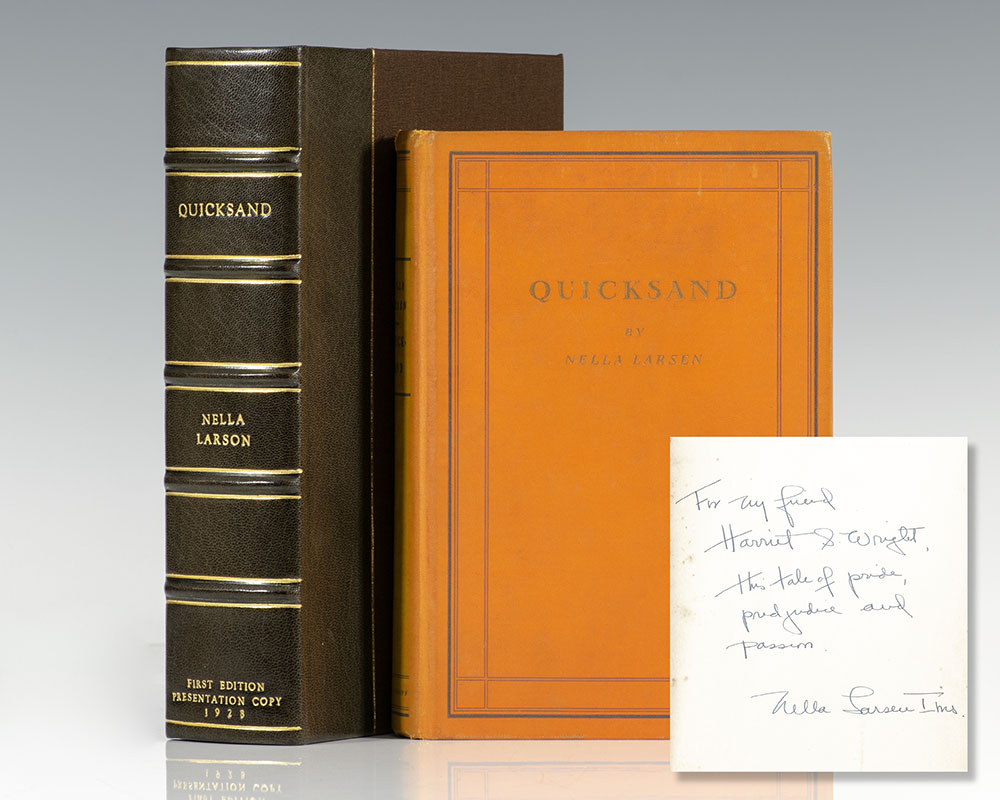Passing.
“I feel like the oldest person in the world with the longest stretch of life before me": First Edition of Nella Larsen's Passing; Inscribed by Her in the year of Publication
Passing.
LARSEN, Nella.
Item Number: 78091
New York: Alfred A. Knopf, 1929.
First edition of this major novel of the Harlem Renaissance by Larsen, who is now widely lauded “not only the premier novelist of the Harlem Renaissance, but also an important figure in American modernism” (The Encyclopedia of Twentieth-Century Fiction). Octavo, original black cloth. Presentation copy, inscribed by the author in the month of publication on the front free endpaper, “For my friends, Lillian and Ed Carlyle from their friend Nella Larsen Imes April 7, 1929.” First editions of any of Larsen’s works are rare, as she disappeared from the circle which brought her fame. After her ex-husband’s death in 1942, Struggling with depression, Larsen stopped writing and returned to nursing and became an administrator. She disappeared from literary circles. She lived on the Lower East Side and did not venture to Harlem. Many of her old acquaintances speculated that she, like some of the characters in her fiction, had crossed the color line to “pass” into the white community. Biographer George Hutchinson has demonstrated in his 2006 work that she remained in New York, working as a nurse. She avoided contact with her earlier friends and world. In very good condition with some rubbing to the spine. Housed in a custom half morocco clamshell box. First editions are uncommon, presentation copies are rare.
Set primarily in the Harlem neighborhood of New York City in the 1920s, the story centers on the reunion of two childhood friends—Clare Kendry and Irene Redfield—and their increasing fascination with each other's lives. The title refers to the practice of racial "passing", and is a key element of the novel; Clare Kendry's attempt to pass as white for her husband, John (Jack) Bellew, is its most significant depiction in the novel, and a catalyst for the tragic events. Larsen's exploration of race was informed by her own mixed racial heritage and the increasingly common practice of racial passing in the 1920s. Praised upon publication, the novel has since been celebrated in modern scholarship for its complex depiction of race, gender and sexuality, and is the subject of considerable scholarly criticism. As one of only two novels that Larsen wrote, Passing has been significant in placing its author at the forefront of several literary canons. Passing was published in April 1929 by Knopf in New York City. Sales of the book were modest: Knopf produced three small print runs each under 2,000 copies. While early reviews were primarily positive, it received little attention beyond New York City. Comparing it to Larsen's previous novel Quicksand, Alice Dunbar-Nelson's review in The Washington Eagle began by declaring that "Nella Larsen delights again with her new novel". Writer and scholar W. E. B. Du Bois hailed it as the "one of the finest novels of the year." In modern scholarship, Larsen is recognized as one of the central figures in the African-American, feminist and modernist canons, a reputation that is based on her two novels (Passing and Quicksand) and some short stories. As of 2007, Passing is the subject of more than 200 scholarly articles and more than 50 dissertations, which offer a range of critical interpretations. It has been hailed as a text helping to "create a modernist psychological interiority ... challenging marriage and middle-class domesticity, complexly interrogating gender, race, and sexual identity, and for redeploying traditional tropes—such as that of the tragic mulatta—with a contemporary and critical twist.
We're sorry, this item has sold.




